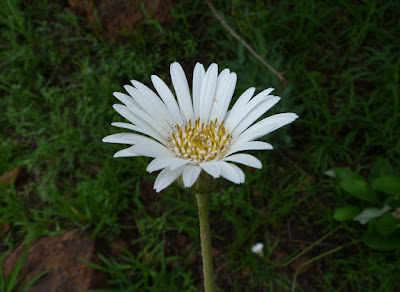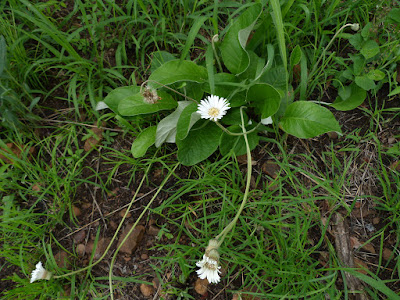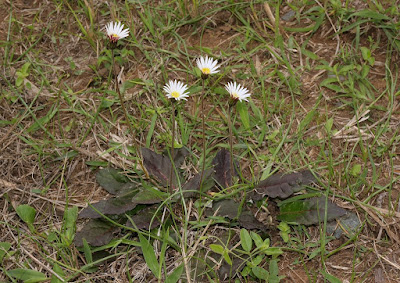Gerbera ambigua is widespread throughout Africa. It grows in submontane areas or westwards on the plateaus, mainly from 200-2000 meters a.s.l...
Gerbera ambigua also called as Pink and white gerbera, Gerbera coriacea, Gerbera discolor, Gerbera elegans, Gerbera flava, Gerbera kraussii, Gerbera lynchii, Gerbera nervosa, Gerbera randii, Gerbera welwitschii, Lasiopus ambiguus, Lasiopus coriaceus, is a species of the genus Gerbera. This species was described by Carl Heinrich 'Bipontinus' Schultz in 1844. The specific name ambigua is derived from the Latin for 'doubtful' or 'uncertain' and is an epithet often applied to highly variable species.
IDENTIFY GERBERA AMBIGUA - PINK AND WHITE GERBERA
Gerbera ambigua is widespread throughout Africa. It grows in sub-montane areas or westwards on the plateaus, mainly from 200-2000 meters above sea level, but reaching the coast in Natal and the Eastern Cape in the south. In open woodland, on savanna, on slopes, in rocky soil, along roads, and in disturbed areas, on clayey soil, on marshy ground, along rivers, in ‘vlei’ or damp grassland, frequently in moister habitats than Gerbera viridifolia.
Pink and white gerbera is a stemless perennial herb with a basal rosette of leaves emerging from a silky crown. The leaves are highly variable in shape, size, petiole length and indumentum (covering of hairs).
This species blooms mainly from September to December but may be found throughout the year from the flower stalks of up to 35 cm. The ray florets are commonly white with a pinkish underside, or more unusually, yellow, with a coppery underside. The pappus hairs, which give the daisy center its colour, may be deep purple or cream.
GERBERA AMBIGUA - PINK AND WHITE GERBERA CARE AND CULTURE
Cultural information should only be used as a guide, and should be to be adapted to suit you. Your physical location; where you grow your plants, how much time you have to devote to their care, and many other factors, will need to be taken into account. Only then can you decide on the cultural methods that best suit you and your plants.
Light:
Gerbera ambigua needs a high light level of between 43000-65000 lux. If the day length is less than 12 hours, supplemental lighting up to 14 hours at 40 watts per square meter is recommended. A photoperiod greater than 14 hours promotes stretching. During the short days of winter, supplemental lighting will greatly increase the quality of the plant.
Temperature:
Optimum day temperature is 22-24°C and 18°C at night. If the temperature drops below 15°C, flowering will be delayed and production time will increase. The plants can withstand temperatures as low as 0°C, but any frost will cause some damage to the foliage.
Substrate and growing media:
Pink and white gerbera can be grown in 9-15 cm pots or in garden borders in either full sun or partial shade with sterile well-drained media with good aeration. Optimum pH is between 5.5-5.8 with an EC of 1.2 to 1.5 mmhos. Initially, keep pot tight for the first four to five weeks after transplant. Then, space before leaves cover the crowns of other plants. Plant crowns require sunlight to form buds. Lack of proper spacing results in delayed flowering, fewer flowers and longer leaves.
Watering:
If grown indoor, water the plant enough to evenly moisten the soil while they are in bloom. Do not allow them to completely dry out. Water non-blooming plant only when the top inch of soil is dry. Drench the plant thoroughly until you see water draining from the holes in the pot. Mist the foliage one or two times weekly during fall and winter to provide humidity.
When grown outdoor, water the plant enough to keep the surface soil evenly moist. Do not allow these plants to dry out during the growing season. The plants that grow in full sun may require water every day or two. Water when the top inch of soil is dry during fall and winter months.
When watering, avoid overhead irrigation to prevent the spread of foliar diseases. The crown should be allowed to dry out between waterings to reduce the risk of crown and root rots. Discourage fungal disease by watering early in the day so that the leaves can dry out before nightfall.
Fertilizer:
Fertilize at 100-150 ppm nitrogen using a well-balanced calcium nitrate based formulation. When established, increase to 150-200 ppm nitrogen for best performance. A pH over 6.0 can induce iron and manganese deficiency characterized by interveinal chlorosis. A lack of magnesium initially results in interveinal chlorosis (yellowing) of older leaves. Boron deficiency is characterized by deep dark green foliage, crinkled leaves and tip abortion. Maintain the media pH between 5.5 and 5.8 and apply 0.25 ppm of boron when fertilizing. Ideal EC is 1.2-1.5 mmhos (1:2 slurry). A pH below 5.5 can induce manganese toxicity characterized by black spots.
Pests and diseases:
Keep insect populations small by frequently checking the plants and sticky cards. Prevent damage by using chemicals on time. Prevent fungal infections by employing good sanitation practices and proper hygiene. Check the plants weekly for diseases and remove and destroy infected plants immediately.
Propagation:
Gerbera ambigua is commercially propagated through division of clumps (suckers). However, tissue cultured plants can also be used for commercial production of flowers. The plants can also grown by seeds:
- Stage 1 (Day 1-5): sow coated or raw seed into a sterile and well drained media with good aeration. A slightly fertilized peat with 20% perlite works well. For optimum results a pH of 5.5-5.8, an EC of 0.7 mmhos (2:1 slurry) and a temperature of 22°C should be maintained. Gerbera are photosensitive during germination, so no top cover is needed. However, if you cannot keep humidity between 70 and 75% a thin cover of vermiculite is recommended. If using a germination chamber provide a minimum 12 hours of incandescent light per day.
- Stage 2 (Day 6-14): Seedlings have now emerged and cotyledons are present. Provide good air movement and with an air temperature between 20-22°C. Lower air humidity to 20-30% and fertilize with 50-75 ppm of nitrogen from a well balanced calcium nitrate based fertilizer around day 10. Gerbera are sensitive to boron and iron deficiency. Maintain media pH between 5.5 and 5.8 and supply 0.25 ppm of boron when fertilizing. It is important to allow the seedlings to become dry in between waterings, but not to the point of wilt, as excess moisture and salts promote distortion
- Stage 3 (Day 15-42): Gradually increase the fertilizer concentration to 100 ppm nitrogen to maintain a media EC between 0.8 and 1.0 as seedlings progress. The young foliage is sensitive to fertilizer salts so rinse foliage lightly with clear water following fertilization. The use of calcium nitrate based fertilizers combined with 20-10-20 every 2nd or 3rd watering works well to maintain proper pH and healthy foliage. During dark weather young seedlings benefit from supplemental HID lighting at 3200-5400 lux up to 14 hours. Under high light conditions seedlings benefit from a light shade of 30-40%
- Stage 4 (Day 43-49): The plant should have 4 true leaves and are approaching transplant stage. Transplant on time to avoid root bound plugs. Overgrown transplants take longer to finish and produce flowers on smaller plants. Reduce fertilizer levels and lower the temperature down to 16°C to tone the plants. Burying the plants too deep and covering the crown with soil leads to blindness.















COMMENTS